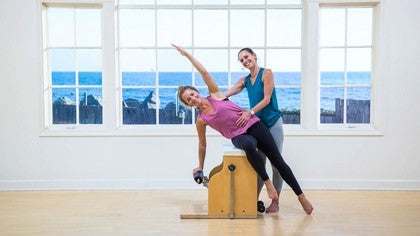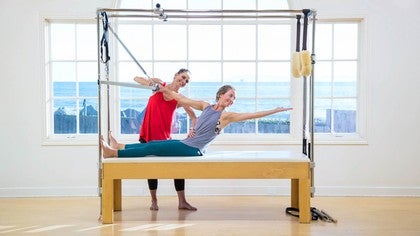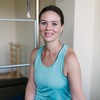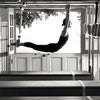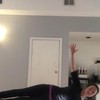Description
About This Video
Transcript
Read Full Transcript
Hi, thanks for being here. We're back with Tucker second session and we're going to move forward with what we built on last time. So starting with breath. So talk, what I want you to do is I want you to sit up all the way tall and I want you to lift your sacrum up your back. So Tucker likes to sit with a little bit of a posterior tilt. So what we're doing is we're getting her into a real neutral orientation of her pelvis and then talk, I want you to just put your hands on either side of your ribs. Yeah, just in a comfortable way. And then I'm going to get my pokey little fingers here.
And what I want you to do is as you inhale and you to see if you can pull my hand in, keep lifting your sacrum and also expand your ribs all at the same time. So inhale, pulling in now deepen this connection. Feel sitting bones squeezing together, pull back, pull back, pull back, pull back, pull back and finish your Xcel all the way. Let's do that again. She's way better than she was and he'll pull in in, in and now think of narrowing the space between my hand and my finger as as you. Excellent. Pull back. Okay. We'll do that a couple more times in here.
So you might even actually see my hand drawing backward and exhale. Don't talk tuck. It's very confusing directive isn't it? When your name is Tucker and we are a lot, we are talking about talking all the time and now one more pulled back. So I asked Hucker to go home and practice those skills and she has, which is awesome.
So I'm just going to come around the back just one more time just to see if I can give you a better visual. We have the abdominals pulling back. There was no talking in the pelvis and then we get that sense of cinching or narrowing. The exhale completely eliminates all the air from the body and Tucker's working really hard to do that. She's, she's done a good job but it's still difficult. Tucker, please step off to the side for me for just a second.
What we have here is the step barrel. And what I want you to do please, is I want you to come sit up on here. So we're going to do some extension to neutral abdominal work, which is also a way to help Tucker, um, organize around this situation with her broken rib. So I'd like for you to reach your arms out in front of you and sit very tall and for tall is gonna feel like you're leaning forward. Okay. So I'm gonna stick my pokey little fingers in here and we're going to inhale and draw in. Nice. And as you exhale, you're going to start to go back.
I want you to pull my hand in very good. Once your mid back comes on top of the barrel, start to bring your arms up. They can are going to go back as you go back. Now, this is not a time that we're just completely relaxing. I want you to keep engaged. Reach your arms around to the sides of you. Lift your face. Look forward.
Now I want this to contract deep, low, and reach forward. I'll get out of your way. Good. Lean a little forward. Inhale. Yes, she's pulling in. Exhale, go back, keep finding it. So she's going to essentially in her mind, work her abdominal muscles. She's still engaging, stretching and reaching back. Reach around to the sides of you. Feel the sitting bones drawing together.
So I'm putting my hand just on the inside of her ASI S and it and I'm doing a little kind of pinching action to remind her how to draw that area or find that sensation of drawing. And let's do one more inhale. Exhale here.
And reach all the way back forward again. Please take your hands behind your head. So I'm going to ask her to bring her hands a little higher up on her school and then to feel that her elbows are reaching out wide and that her shoulder blades are coming a little bit forward. And now tuck. I want you to do the same thing. So you're going to roll back, pulling your abdominals in as you go, and you're going to do that same thing where you're working. As you go over the top and your head is just being cradled by your hands.
Now as you inhale, I want you to think of expanding outward into my hands. That's gorgeous. Pull your abdominals back. Think about the space below your belly button as you begin to lift big into left. Now pause there. Go a little bit more extension the other way there. Now inhale and pull me in. Thank you. Exhale, pull me in and go back.
This is a more difficult skill than just lying down and lifting like you're doing. Okay? Okay. Inhale, prepare. Exhale left. Find your straight line. Think of diagonally reaching. That's right tot. Good lift a little more. Yeah, reach a little longer. Inhale and Exxon. I'm just keeping my hand right here. I'm keeping her honest and also making it very difficult for her.
Go all the way back and he can in here without lifting the tailbone. Thank you.
You know there's the rib cage is wider than this band is the end of the story. So sit here and I want you to sit quite close to the front of the chair and tell me if I need to move that sticky pad at all. Okay? So if you'll remember what we did with the band is we crossed it.
But you're doing it from down here too or now you are. Okay. Okay, so we did that. Just reminder of what the band does and we're going to go right on the heels of the foot. Feet. Okay. So I'm going to get in close. We're going to get this lifted up even more. Thank you. We're going to get this drawn back. So I want you to all the time Tucker, feel that this is lifting. Good. Now I want you to inhale, expand into that band as you exhale. Start breathing out from here and press the pedal down.
As you're pressing down with your legs, I want you to feel as though you're lifting your spy and lift your knees. Okay? So I want you to bring your awareness to that little bit of instability in the pelvis and know that it's not important to get the pedal to go all the way to the ground. But what is important is that the, the torsos being held still. So here we go again. Inhale, pull and, and pull my fingers to my hand that's behind you and push. Ooh, much better. Still a little bit of a rocking at the bottom. So I'm going to change my hands. I'm going to trust you to be honest here. I'm going to put my hands on her pelvis like this. So I'm holding ASI, S P S I S in my hands and I want you to contract the tissue between my hands.
Push down, but stabilize bad or good. I'm going to say don't go quite as far down. We're working on three, three. That means two Springs on the third choice. Push down, make it small enough. So you can stabilize. That's better now left.
No, I'm going to do all of those things. So pelvics still pull my hand in. Lift your sacred. Thank you. And lift your knees Paul. And that was the best one. Good VA, whatever you should shifted there Tucker. Do you know what? You shifted on that one to make it better cause it was the best one. Yep.
So she says she started her breathing first. So let's do that again. Cause that made a big difference, right? It's hollowing out that pelvic bowl. Very good Tucker. Let's do one more. Start your breath. Don't move until you find your contraction. Okay, nice work. Let's move on to the toes.
And now pull in and press down. Now this squeezes and ah, so I don't know if you can see where my hands are, but what I'm doing is as she presses down and I'm encouraging her to find this connection here and now I'm really poking her, but I'm not poking her all the time. I'm just kind of speaking to her musculature at the Tucker. That was the best one. Except we tucked at the end. Let's do three more. Three more chances.
Polan find that breath. [inaudible] yeah. Good. And keep really using that band to, to um, breathe into, expand into their ribs. Very nice. Press down your left hips wanting to pull forward. I can feel that I couldn't see it, but I could feel it with my hands, which is one good reason to use your hands. If you feel comfortable, they can oftentimes give you valuable information that you might not otherwise. Oh, I see. Takes a while to get comfortable being this bossy with your hands.
But stick your butt out. Thank you. One more. Stick your butt out first, then pull your stomach in, then move the pedal. Thank you. Oh yeah. Okay. That's good. So let's bring the heels together, toes apart. Now you still [inaudible] banding and contracting that band and you can really use your arms to help you. You know, you don't have to do it in unless you want to, but it might help. So lift your, bring your chin back towards your neck and lean forward a little there. No, here we go. Inhale, tighten your glutes. Stick your butt out. Pull your stomach in. Start your breath and push her. Allie. Good and left.
Tailbone back. Tighten the external rotators. Squeeze your inner thighs, pull your stomach in. Use your breath to move the pedal. So what I sometimes that was a little much. Yeah. So what I sometimes like to think about on the chair is there's two oppositional energies. The down push with the legs and the uplift with the spine, with the trunk. So as the legs are pressing down, the spine is floated. Oh, that was different. Did you feel that?
Did you see that? I did go very good. And that actually is helping you to stabilize a little bit better. Can you feel what I'm talking about? Okay, awesome. So another thing to think about and I'm just layering on information. Um, you know how when you, when we worked on breathing the legs up towards the body with the abdominals. You can do that here too. Ooh, that's a little too much. Pelvis come back. That's right.
So again, I can help her navigate and I can also really understand where she is just by, that's right. By measuring with my hands when I'm not doing the work for her, I'm actually gathering information more than anything. Last one. That's so good. Yes. I think that might've been the best one all day. That last one. Very good. We're gonna stop there.
So I'm going to take this now what we're going to do is get a little meaner. So which just, well maybe not right now. So step off the chair, Tucker. I'm just going to put the band aside. I'm going to turn and we're going to do a little bit of calf work. How did that spring feel to you? Good. Okay. Do you think you're going to be able to push it with a foot? Yeah. Okay.
So what you do is you put one of your knees just underneath the patella on that pad and you put that foot on the chair. Yeah. And then there's like a little divot there underneath the nivo. Okay. And then the other leg, please, I want to come down onto the ground. So we're going to take a couple of minutes to get a really good setup here. I want this to slide back towards me kind of far, but enough so that you can really drop that drop into that stretch.
And now what we're going to do here is we're going to level out the pelvis. We're going to lift the chest. Your hands are perfect as they are. Now here's another way. Here's another place that just seems like what I, she's just moving her foot. No, we're going to find the breath. We're going to find a deep connection.
And then we're going to articulate through the foot. Go push down, pull in
And that if you watch my hand, if you can see it, you might see it pull back towards my back more and more and more. That's right. Right. So we're narrowing this space. That's enough. I think it was eight. What do you think? Were you counting? Was it 10 okay, let's switch sides.
So we're going to block it. Okay? I want you to don't go. So what we're looking at here is the organization of the pelvis. So you're a little bit forward with your right hip, which is not surprising. And um, take your body a little forward. Okay, now breathe in and blocking her from doing what she wants to. Eventually she'll do that on her own hamstring. Oh, okay.
So something different is happening on this side. As you go to push with your foot, Tucker, what you're doing is you're bringing your pelvis around the front. Okay? So what I want you to do, there's then a whole new piece here. I want you to start by pulling this down towards my foot. That's it. Now keep it down. Find your hamstring, find your abs and move your foot.
Thank you. And lift your foot. Find your pelvis. It's not, it doesn't come from the ribs though. Comes, it's like a, it's that
All right, so what I'm going to ask you to do next is I'm going to ask you to just walk around to the back here. So one thing we know about the rib, the, the broken ribbon is that a lot of really deep flection doesn't feel great, but flection is also available. So we're going to do some extension to flection movements. So we're going to do the reverse pike standing pike. I want you to step quite in close. And then I want you to stand up nice and tall. And as you exhale, I want you to round over the chair and take your hands over the top of the chair and arrest them on the pedal. Heels of the hands on the pedal. Okay?
So let's get you to come
So yeah, stick your [inaudible]. Yep. And as you lift your pelvis up into my hand, you're going to send your chest down. I want you to lengthen. Don't, don't think about necessarily going all the way down first. Think about going out. Yes, we're going to find that beautiful extension. I'm a big ponytail polar. They make a great handle. So go now go a little lower if you can. Now that's beautiful.
So we get that nice long position in your back. Your shoulders look great. We're going to breathe in and then I want you to lift from your ribs. Soften here. Let your pelvis rotate under so you're coming back up. But keep creating that long rounded shape. Very nice. And you're deepening into here. That's very beautiful.
Now the tailbone lifts up, so you're imagining that you're pouring your pelvis forward. So these bones become higher than these bones.
Push forward on the pedal. So you're using your arms to create something to pull against. You can go a little bit more with your pelvis. How does that feel in your red super. Let's do that again. Lift your pelvis.
Reach out, out, out, out at, out at, ah, that's so good. And now from the pelvic bowl, lift my fingers up in towards your sacrum. Nice work. She's working very, very hard. It's hard to see cause she's doing such a beautiful job that she's really trying here. Let's do one more. So the space between the ribs, your little rotated. Again, the space between the ribs and the pelvis gets increases, increases, increases.
We're filling up, their lungs are filling up the backside of the body and now we start connecting the lowest, lowest low as part of the torso to bring that pedal back up. I lied. I want one more. Okay. So here we go. Remember the widening and widening into the ribs. You're leaning to the right. That's uh, that's, yeah. And now go down. This is lifting. This is where irritation is there. Okay?
So we get that nice flat line in the spine and now I've put my hands or head a kind of inside of her ASI. S she's, I can feel that she's pulling back, pulling back, pulling back, pulling back, pulling back. And now Tucker, when you come to the top of the spring, I want you to just start lifting up, lifting, lifting, lifting, lifting up and lifting up. Okay? Very beautiful job. I'm going to get a mat. Okay. So we've, uh, put Tucker down on the floor. And I didn't mention that when we did the standing pack. Reverse. I had changed the spring. So the Springs that we did footwork on would have been too heavy.
So we went to a zero three for the standing pike reverse. And now we're at that same zero three spring. So Tucker, what I want you to do is to bring the soles of your feet together. This exercise is called the hip opener and you're going to put put it down. We're sticking. That's okay. We're sticking with some with still some pretty basic movements, but we are starting to implement more choreography, which is good for Tucker cause she's a student and she needs to learn it as low as, but the most important thing was that we learn the fundamentals first. Okay, so Tucker has her feet together, the pedals all the way down.
So what I want you to do is I want you to get organized so that your spine is neutral. So that means you're going to drop your rib cage. Remember it helps to let the arms be a little, I'm going to let her have her arms a little wider than I might ask someone because it helps her to let her chest sink down in between her shoulder blades. Sometimes if we'd get to pinch in our shoulder blades, we don't have anywhere to put our ribs, so I've let her soften her arms so that she can soften her ribs down towards the floor. We're going to drop the back of that right hip. And then what we do here is you can put your hands on here in both maybe and keep your elbows wide. So now you to lift the pedal about there and as you exhale, I want you to feel you start your breath and then you push the pedal back down. Okay, so talk, we're Tucker. We're going to do that at a little differently.
Lift the pedal again. So you do your breathing thing. I'm trusting you to be very honest there. So what happened before? Good. Do what you did before is that what Tucker did is she pushed down with just her feet. So what she's actually doing is changing the knee. And what I want her to do is feel her hips working. So please lift your feet again. You ready?
So instead of pushing your feet down, what I want you to do is I want you to think of pressing your knees apart, not your feet, your knees apart, your knees apart, your not your feet, not your feet, your knees apart, your knees apart, your knees apart. Do you feel that little differently? Yes. She feels her hips burning. Now as the MRI now lift your feet again. So if you've done this exercise and you've never felt it before in your glutes, this is how you do it. You spread the legs wide. It's like you're trying to open the knees, open the knees, open the knees, open the knees, and it's visually different. I hope you can see.
Lift your feet, start your breath, find your depth, find your right pelvis, open your knees open. That's so much better. You feel how deep it is? Good. We're doing two more. Only lift your knee a feet
We're still expanding into the rib cage and we're still contracting. Oh, that was good. Yeah. Keep those heels together please. Thank. Yeah.
So I think you're going to have to be a little further back cause what I'm gonna ask for you to do is put your heels on the mat. Yep. And I want you to stand with your feet. Kinda wrapped over that pedal in like a prehensile shape.
You know what to do. You're going to breathe in.
Let the ribs soften. Reach out from the place that feels sticky in your body, where your ribbon is. That's where it's hard to keep that pedal down and you'd just keep it in the, you did a very beautiful job. Dropped the back of the right pelvis and
We all have our things. Very good. Oh, the way I did. Thank you. You did the right hit that time. Good job. Lift your feet. Okay, so make your way up to sitting. What I'm going to have you do next is I'm gonna have you scoot your pelvis forward so that the arches of your feet can come up onto the edge of the chair and then you can put your hands on that pedal and push it down a little bit so your legs can straighten you. Okay? Okay. Now this exercise is a great exercise to look for the deep abdominals.
So what I want you to think about is I want you to get a little more long and a little bit more around. Okay? So I'm going to put my hands on you and I don't want you to push out on me. I want you to inhale, prepare. As you exhale. I want you to pull my hand in and press down.
What happens oftentimes is people are, we tend to go again, one, I'd make it really into an arm exercise and we forget all about the abs. Yeah. So what I want you to think about is that you're really finding your abdominals and as you find your abdominals, you're almost rounding your spine to put pressure on the pedal. So now that's not a moving cue. She's not actually moving her spine. But what I'm asking her to do is think of going deeper into the curve that she's already making. Don't push out on me please. Thank you.
Yeah. Can you see when you push on my hands? I just keep your eyes down there.
Start your breath. Use your breath. Pull back. Pull that. Thank you. Thank you. Thank you. Thank pullback G shaking. Okay, so go ahead and a little bend your knees, lift the pedal and you can just take your feet down. I'm going to just grab a box. So sit tight here. Okay. So what I have here is just this small moon box. Um, if you don't have a moon box, you can sit on a couple of pillows. You can even sit on the floor if your shoulders are flexible enough.
I find that it helps to be a little bit more up. So yoga block, couple of cushions, anything like that we'll do, but just slightly, slightly raised from the floor was still on that three zero spring and tuck. You're just Tucker. You're just going to come and sit down. I like to call Tucker tuck, but we've decided that saying tuck makes me sound like I'm telling her to talk. So I'm trying to get out of the habit and just call her tuck in my personal life. Okay, so what I'm going to do is I'm going to push this pedal down, and the way I like to do it actually is I like to sit on the chair so I can control the pedal. And then what you're gonna do is you're just going to sit back and put your hands down on that pedal. There'll be just on the outsides of the box.
Now what you want to think about here, I'm going to take my feet away. You're in charge. Now, this can be done on a little bit of a heavier spring, but we're going to start here and see how we go. So what I want you to do, take your feet a little further forward and then I want you to lift your spine and what it's going to feel like is that you're leaning away from the chair even more. So it's going to feel like your arms are quite far behind you, and that's where your body is up, right? I'm measuring the space from her shoulder joint to her greater trocanter. I'm looking for that to be in alignment. So now what I want you to do are going to start speaking about the mid back stabilizers.
So these muscles right here without pinching the shoulder blades together at all are where I want you to be working from. So I want you to write before you've been doing anything else, push down on the paddle from here and I can feel that I can. I can feel that contraction. So now Tucker, please allow your scapula to lift straight up. Not forward, not back. Just straight up. Very beautiful. You're inhaling. Okay, now stick your bat out. As you exhale, pull in, push down, lift your spine, squeeze my hands together. Inhale, pull and lift. Your scapulas straight up start. Exhaling.
Don't change your pelvis. Pull in here. Lift your spine. Don't push out on my hands. Pull my hands together. Thank you. Left up poor. Tuckers can I get tired of having my hands all over her pelvis? Squeeze in, but Oh, thank you.
What she just did is lifted her sacrum, which I really appreciate it. Good and push straight downs. Thank you Tucker. But pull my hand in more. Thank you. Now go again. Two more times. He feel your mid back. Say crumb stomach. All the air goes out of your body. Thank you. Really good.
One more. Seagram stomach. She's actually creating space between her, um, stomach and my hand. There's a, there's a hollowing that's happening in there that I don't know if you can see, but that if you look, yeah, you can see how she's not touching me at all anymore, which is amazing. Lift here more. Now what I want you to do, we're changing the exercise. I want you to stay involved here. Keep thinking about your breathing. Inhale, bend your elbows. Pull your stomach back. I know I'm blocking you. You can't go any further. Push down from your mid back. Inhale, lift your elbows, lean back a tiny bit.
Exhale, start here mid back, pushes the pedal down. Say Crum lifts. Inhale, bend. Create that space for me. Keep lifting your cecum. Press down. Have very good. Inhale. Two more. Pull in here for me. Push down and the left stuck her. One more.
Thanks. Thanks for doing that. I'm going to have you sit on the chair. Please sit on the outside of your right hip. Stretch your left leg long to the side of you. We're going to start on her, um, her compromise side. And the first thing that we want to do is we want to make sure her body's in a straight line. So what we're going to do is get the head to go straight. And so Tucker, what I want you to focus on doing is to reach out that way with your energy.
Okay, so now I like this. Let's just take the arm a little forward and we'll bring it up. How does that feel on your shoulder? You good? Okay. So we're gonna SA, we're gonna connect into this bottom shoulder blade and just hold that connection all the time. So now as you inhale, Tucker, I want you to go push on my leg with your leg a little, bring your, your left leg, left leg onto my leg and push on it. Oh, we'll just help her keep her pelvis is the reason I asked her to do that. So now you're going to go down. Inhale.
Just lean into the spring and I want you to pull your stomach in. Thank you. And now that energy I did when I pulled on your face a second ago, I want you to do that as you lift up. So this draws in deep, this less, you're not extending through there, you're reaching out. And so the intention is how does that FIA, you're doing really beautiful. So the intention is is to breathe in and really expand into the inhale into these upper intercostals to not rotate at all. And I'm just watching for that.
And then to feel that sense of breathing the front of the body into the back of the body from below the belly button from the pelvic bowl. And then just coming back out into that nice long line. Still good. Good. Let's do three more. Inhale down. So I just gently rest. I have one hand on her sacrum and one hand on the front of the sacrum so I can assess if she's using the muscles that I want her to be using.
And I can also feel for the clicking and the rib and I don't feel it. Do you? Super. Let's do two more. Inhaling down. You're leaning a little forward. Come back. So if at all possible, I know I have said a lot of times I'm going to put my pokey fingers on your body. I'm not actually really poking her. Um, I'm trying to be pretty soft with my hands, but instead just mostly using my for feedback to help her understand where I want her to engage or a fire or Titan. Yeah. And just also encourage her to be in a straight line.
Tucker lean all the way down. I'm going to give you a reward. I'm just going to get rid of a little stretch here and put what I'm holding her leg with my leg. Keep your foot reaching for the ground and have one hand on her pelvis and one hand just under her shoulder blade and I'm in a pool. I feel good. And then just make your way up. Yeah. Good. And what I liked that she did there is instead of just, sorry I D stabilized you. I turned around and turned around the other way. Uh, but I liked that she did was she collected all her things instead of just sitting up cause she knew she was done. She came with um, with integrity. So lean over, put your hand down.
So now this side could be tricky too, right? Cause we want, what we want on this side is instead of squeezing the ribs in is we want to keep them elongating as well. Let me know if you have trouble with that. Take this arm up. Your arm can come a little forward. Okay. That feels okay on your shoulders. Okay. So we're just going to lightly engage under here and we're going to inhale and go down, expanding into these ribs, lifting up out of that side of the body and then as you exhale to come up, reach out into that opposite side of the room. Nice. Nice. Nice. As she's lengthening up out of this space, which is where she feels discomfort, I think it felt good. Yeah.
Reach out. Breathing, breathing, breathing, breathing, breathing, stretching those ribs nice and open. So what we learned about talker earlier is that she likes to really bear down in her external oblique. So her intercostal muscles are quite tight. And what we're trying to allow her to do, reach out as you go over, pull this lightly down, is to not only strengthen her body, but also stretch the parts of her body that she's created a tightness pattern in. Do you feel how it went? So what I just did it, I shifted her pelvis forward cause I could feel that her back was working a little bit more than her front. I could feel it in her tissue. Go down two more times. So I just did it and she nodded. Um, but then I thought that maybe you guys are wanting to know what we were talking about without saying any words you're using your back more now again, come here.
That's better. That's better. That's better. So on this side of her body, which is probably part of that right hip complex thing, she likes to use her back a little more than her front. This is the last time. So if you feel this working more than this, you notice shift the pelvis a little forward and just bring your fire. That's better. Very good. Very good old. I'm still squeezing down here. Good. And go one more time over for your stretch. A different strategy for the stretches. Not to hold the leg, but just to hold the pelvis and the shoulder blade and it go at it this way.
They both work. Which one's better, Tucker? Yeah, she likes the leg holding. Okay. All right. So what I want you to do now, Tucker, we're gonna do one more exercise. I want you to lay down on the chair and I'm actually going to have your torso on the chair and I want you to put your ASI as bones right at that front edge of the chair so you can kind of hook the front of your pelvis around them. Just like that. Good. So I'm asking her to too, and I don't, you don't necessarily need to arch your back so you can let your pubic bone settle. But I also don't want you to wrap around the chair. You see what I mean?
Okay, so push the pedal down please. I'm just going to tuck your tag in for you because, okay, so we're going to start all the way there. What I'm going to ask you to do, Tucker, is create your back extension from your mid back. So that means this space between the pelvis and the bottom of the ribs. I want you to hold fairly still and then we'll push towards me with your hands back into the pedal. And then you're going to lift right here.
Stop there for a second thing of going forward with your sternum. That's right. Lean a little to the left and go down. So we'll inhale on the app. K, little bit of a backward press into the pedal, right where the crisscross happens in your bra. So where you can think of this pulling forward. Yes, yes. So what I sometimes imagine go down again, I'll say it in different words all the time. Lean a little to the left. You just work more on your right side.
What I sometimes imagine is that we get that mid-back working and then as the breastbone goes up in for these back rib bones have to drop down to allow for that movement to happen. And I hope that you can see what she the how's that sh how that is shifting because she's doing a really amazing job finding it. How about one more time. How's this feel with your pelvis? Nice and steady. Good. So I want, I want to teach my students to use their mid back before I start bringing them into a position where they can just rely on the curvature in the lower back to lift and lower them. Did I say one more? Did I say one more? Let's do one more.
Katie. Shoulderblades Austin, just reaching out and forward. Left rib dropping, leaning a little to the left. Okay, good. And now go back down again and bend your lift the pedal that one's the Springs. Let go.
You can put your hands on the chair and you can just help yourself up from there. Standing up nice and tall. Let's finish with a roll down. So I'll just pull this forward actually, and you'll have plenty of room there. Take a tiny step forward. Take a breath in. Now that same thing that we focused on in the standing pike and the kind of going around that space, maybe a little less so head first so that it would happen more in like that section in your, of your body, dropping the head all the way, feeling that there's Wade in the feet, both of the feet. And now we're going to lift. Ah, now here's where you're stretching out. Your pelvis can continue to move, but that low back, it's a nice long stretch. As you come up to standing on both feet.
We'll do one more lifting this section, keeping that area drawn back and up. Rolling in and back, squeezing the two hip joints together. Yeah, look at you. So totally different set of organizational skills than last time. So I'd like to commend you for your good work.
Keep practicing and we will continue forward from there. Welcome.
The Teacher's Corner: Mentor with Meri
Comments
You need to be a subscriber to post a comment.
Please Log In or Create an Account to start your free trial.
